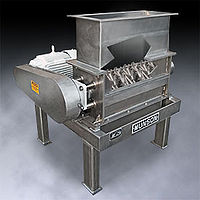Difference between revisions of "Screen Classifying Cutters"
(Created page with "Category:Particle Size Reduction{{Knoppen}} <noinclude><!------------------------------------------------ * READ THIS FIRST * Only edit this page if you can improve the c...") |
PurplePen19 (talk | contribs) |
||
| Line 5: | Line 5: | ||
* Please do not edit the sponsored link on the top right corner. . | * Please do not edit the sponsored link on the top right corner. . | ||
* Please start editing this page after the /noinclude | * Please start editing this page after the /noinclude | ||
* -------------------------------------------------></noinclude> | * -------------------------------------------------></noinclude> | ||
[[File:Screen Classifying Cutters_1.jpg|thumb|200px|right|Screen Classifying Cutters]] | |||
[[File:Screen Classifying Cutters_2.jpg|thumb|200px|right|Screen Classifying Cutters Blades]] | |||
'''Screen Classifying Cutters''' reduces hard, soft and fibrous materials into controlled particle sizes at high rates with minimal fines. Applications include a diversity of food, chemical, mineral and plastics products such as grains, minerals, foundry materials, wood chips, regrind and fiberglass insulation. | |||
==Design== | |||
Screen Classifying Cutters eatures a proprietary rotor design comprised of cutter heads attached to a helical array of staggered holders called "interconnected parallelograms" that continuously shear oversize materials against twin, stationary bed knives. | |||
The cutter tips, which are available in stainless steel, tool steel and tungsten carbide, can be slid onto blade holders and secured with one retaining socket-head screw, allowing rapid replacement. | |||
==Operation== | |||
Material is fed through the top of an adjustable, double-baffled intake chute, or directly into the front of the chute through a hinged door. An independently powered, variable speed pinch roller is offered for horizontal feeding of material. Discharge is via gravity, pneumatic transition or independently powered belt or screw conveyor. | |||
==Video== | |||
<youtube>oQzYiyXoQfk</youtube> | |||
Latest revision as of 09:14, 15 October 2012
Screen Classifying Cutters reduces hard, soft and fibrous materials into controlled particle sizes at high rates with minimal fines. Applications include a diversity of food, chemical, mineral and plastics products such as grains, minerals, foundry materials, wood chips, regrind and fiberglass insulation.
Design
Screen Classifying Cutters eatures a proprietary rotor design comprised of cutter heads attached to a helical array of staggered holders called "interconnected parallelograms" that continuously shear oversize materials against twin, stationary bed knives.
The cutter tips, which are available in stainless steel, tool steel and tungsten carbide, can be slid onto blade holders and secured with one retaining socket-head screw, allowing rapid replacement.
Operation
Material is fed through the top of an adjustable, double-baffled intake chute, or directly into the front of the chute through a hinged door. An independently powered, variable speed pinch roller is offered for horizontal feeding of material. Discharge is via gravity, pneumatic transition or independently powered belt or screw conveyor.
Video

